Serviços Personalizados
Journal
Artigo
Indicadores
-
 Citado por SciELO
Citado por SciELO -
 Acessos
Acessos
Links relacionados
-
 Similares em
SciELO
Similares em
SciELO
Compartilhar
Revista Lusófona de Estudos Culturais (RLEC)/Lusophone Journal of Cultural Studies (LJCS)
versão impressa ISSN 2184-0458versão On-line ISSN 2183-0886
RLEC/LJCS vol.8 no.1 Braga jun. 2021 Epub 01-Maio-2023
https://doi.org/10.21814/rlec.3211
Thematic Articles
Biopolitics of Light in Modern and Contemporary Cities: From a Disciplinary Light’s Eye to the Operational Lights of Control
1Escola Superior de Propaganda e Marketing, Rio de Janeiro, Brasil
In this article, we seek to explain some of the relationships between light and biopolitics in modern and contemporary cities. We consider light as an external stimulation capable of not only impacting and sensitizing bodies, but also influencing them in different ways and to different degrees. Based on this premise, we ask ourselves how, in modernity and in contemporary times, the luminous materialities and practices of urban space have the capacity to influence, determine, capture, monitor, discipline and control the opinions, discourses and practices of individuals. In order to outline some partial elements of response to this wide-ranging problem, we first try to demonstrate how public lighting in modern Paris can be considered a disciplinary technology. Then, we ask how light can, even today, participate in different power strategies. Starting with Paul Virilio (2002), we argue that there has been a shift in control strategies through light in relation to previous times. Subsequently, a distinction is proposed by the author, outlin- ing two regimes: the first, coming from modernity, is characterized by the use of “direct light”; to this, we can now add a second regime of “indirect light”, characteristic of societies of control. Thereby, we attempt to denaturalize our relationship with light, in the context of western culture, and recognize its role in the service of photo-politics, a term that we propose to designate some of the (bio)political instrumentalizations of light. Finally, analyzing contemporary insurgent luminous artworks and practices, we reflect on the possible strategies through which insurgent lights could be raised.
Keywords: biopolitics; genealogy; light; media; politics
Neste artigo, buscaremos explicitar algumas das relações entre luz e biopolítica na ci- dade moderna e na contemporânea. Consideramos a luz como uma estimulação externa ca- paz não apenas de atingir e sensibilizar os corpos como também de agir, de diversas formas e em diferentes graus, sobre eles. A partir dessa premissa, nos perguntaremos de que maneira, na modernidade e na contemporaneidade, as materialidades e práticas luminosas do espaço urbano teriam a capacidade de influenciar, determinar, capturar, vigiar, disciplinar e controlar as opiniões, discursos e práticas dos indivíduos. Com o intuito de esboçar alguns elementos parciais de resposta a essa abrangente problemática, buscaremos demonstrar, em um primeiro momento, de que maneira a iluminação pública da Paris moderna poderia ser encarada como uma tecnologia disciplinar. Em seguida, nos perguntaremos de que modo a luz poderia, ain- da na contemporaneidade, participar de diversas estratégias de poder. A partir de Paul Virilio (2002), argumentaremos que houve um deslocamento nas estratégias de controle por meio da luz em relação a épocas anteriores. Retomando uma distinção proposta pelo autor, queremos delinear dois regimes: o primeiro, oriundo da modernidade, que se caracterizaria pelo emprego de “luz direta”; ao qual se acrescentaria hoje um segundo regime de “luz indireta”, próprio às sociedades de controle. Desse modo, procuraremos desnaturalizar nossa relação com a luz, no contexto da cultura ocidental, e reconhecer seu protagonismo ao serviço de foto-políticas, termo que propomos para designar algumas das instrumentalizações (bio)políticas da luz. Por fim, analisando obras e práticas luminosas insurgentes da contemporaneidade, buscaremos refletir sobre possíveis estratégias através das quais poderiam ser erguidas contraluzes.
Palavras-chave: biopolítica; genealogia; luz; mídia; política.
Modern Lights: Paris, City of the Disciplinary Light’s Eye
In a satire entitled “Les Embarras de Paris” (The Embarrassments of Paris), the French writer Nicolas Boileau (1872) describes the chaotic atmosphere that once reigned the streets of Paris at night in the second half of the 17th century. The dangers described by the author cause him such fear and apprehension that he does not risk leaving his home after sunset. In a poem, he sketches nocturnal Paris with some irony:
the deadest and least populated forest / Is also, compared to Paris, a place of guard. / Unlucky is the one that, for an unforeseen matter / Ventures him- self in the street, a little too late, and takes a risk? / Soon, four approaching bandits will ambush him, / Your money!... It is necessary to surrender; or not: to fight, / So that your death, of tragic memory, / Of the famous martyrs fill the history. (...) / I hear screams, everywhere: Help! I’m being murdered! (Boileau, 1872)
Facing the “no man’s land” described by Boileau, it is no wonder that the authori- ties sought to domesticate this “night jungle”, as they did in 1667 with the introduction of street lighting in Paris by royal decree (Schivelbusch, 1983/1993, p. 75).
Yet, the search for greater security through street lighting in the French capital be- gan before the 17th century. In his book La Nuit Désenchantée (Disenchanted Night) , the German cultural historian Wolfgang Schivelbusch (1983/1993) states that, even in its more archaic form, by the end of the middle ages, public lighting was employed to introduce order into what amounted to dangerous nighttime rampages. The fear of the medieval night disrupted daytime activities and led to a withdrawal into the house:
each evening, the medieval community prepared itself like a ship’s crew preparing to face a gathering storm. At sunset, people began to retreat indoors, locking everything behind them. First the city gates, which had been opened at sunrise, were closed. (…) The same thing happened in individual houses. They were locked and often the city authorities took the keys for safekeep- ing. (Schivelbusch, 1983/1993, p. 71)1
while the inhabitants of a medieval town locked themselves into their hous- es like sailors battening down below decks, the night watch patrolled out- side, keeping a check on the nocturnal no man’s land. Every night, a curfew (Ausgangssperre, couvrefeu) barred the people from the streets, something that nowadays only happens during times of civil unrest. (p. 72)
According to Schivelbusch (1983/1993), night watchmen brought lanterns not only to illuminate their night patrols, but also as a statement of authority - their lights as a highly visible symbol of power. To us, the wandering of the night watchmen also seems to aspire a sensory occupation of space through light.
While lantern carriers are, in a sense, a primitive form of street lighting, the author reports that new techniques soon arrived. In the second half of the 16th century, the first street lighting prototypes materialized in Paris. In 1551, parliament issued an order that the city’s residents,
every night before six o’clock, during the months of November, December and January, should hang a lantern with a candle under the level of the first- floor window sills, in such a prominent position that the street received sufficient light. (Schivelbusch, 1983/1993, p. 73)
More than simply illuminating the street, this practice, as Schivelbusch (1983/1993) argues, was intended to show the authorities the position of each dwelling so that struc- ture and order could be introduced into the city at night.
Toward the end of the 17th century, these first achievements gained a more central- ized organization when, in 1667, the French monarch enacted mandatory public light- ing. This transformation was part of a series of measures launched during the period of the French absolutist monarchy that aimed to modernize the streets. Such renewal also involved housing alignment and pavement management by the authorities. Henceforth, the installation of lanterns on the street was no longer the responsibility of the inhabit- ants, but of the public authorities through the police, who were in charge of this thor- ough, judicious and drastic regulation (Schivelbusch, 1983/1993, pp. 74-75).
It is significant that, as Schivelbsuch (1983/1993) reports, the reverbère - a model of a street lighting lamp (Figure 1 ) - emerged in the context of a competition organized by the Parisian police in 1763. The innovation of this device was the ability to attach a metallic reflector to the lantern, considerably increasing its luminosity. We can, therefore, ask whether the search for a luminosity enhancement of lanterns is not inseparable from the desire to establish greater efficiency in surveilling and controlling the population. This interrelationship between light and the security apparatus becomes even clearer if we consider, as the author reports, that public lighting in the 18th century was the great- est expense in the budget of the Parisian police (Schivelbusch, 1983/1993, p. 85).
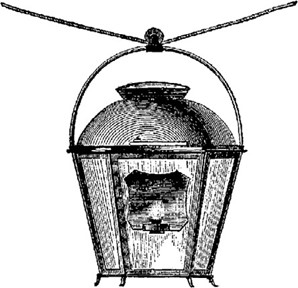
Source. From Les Merveilles de la Science, por L. Figuier, 1867 (https://fr.wikisource.org/w/index.php?title=Fichier:Figuier_-_Les_Merveilles_de_la_science,_1867_-_1891,_Tome_4.djvu&page=3). In the public domain.
Figure 1: Street Lighting Setback Design
At the end of the 18th century, Paris had 3,500 streetlights that guarded the city at night (Schivelbusch, 1983/1993, p. 84). During the 19th century, this luminous presence saw significant growth, reaching 5,000 lamps in 1814, 9,000 in 1826 - when gas lighting was introduced - and finally, 10,000 in 1828 (Benjamin, 1982/2009, p. 608). As a result, street lighting brightened the urban fabric and the bodies that circulated within it while decreasing the possibility of remaining unnoticed in the night city. “Not a single corner or crossroad / That the street light does not reach”, say the verses of the French poet Jacques Fournier about the Parisian streets at the end of the 18th century, as transcribed by Walter Benjamin in his book project Passagens (Passages; Fournier, 1854, as cited in Benjamin, 1982/2009, p. 612). This overexposure of the capital’s residents also emerges in the reports of lantern carriers, still present at the end of the 18th century as a mobile lighting service (Schivelbusch, 1983/1993, p. 78). In his Tableau de Paris (Scenes from Paris), published in 1781, the scholar Louis-Sébastien Mercier (as cited in Schivelbusch, 1983/1993) describes these as lights that swirled around the city:
the nocturnal wanderers with their torches are in the service of the police and see everything that happens; thieves who want to force open locks in he back streets can never be sure that their unexpected lights will not turn up. (...) The torch-bearer goes to bed very late and next day reports every- thing he noticed to the police. Nothing is more effective in maintaining order and preventing various mishaps than these torches, which are carried around here and there; their sudden appearance forestalls many a noctur- nal crime. (p. 78)
The way these sudden lights participated in both the security and night surveil- lance of the capital is also highlighted by Maxime Du Camp in a book published in the second half of the 19th century. In this book, the author reports rumors that the Parisian lantern carriers, after following the population’s nocturnal movements, “voluntarily gave accounts every morning to the lieutenant-general of police on what they had noticed during the night” (Du Camp, 1875, as cited in Benjamin, 1982/2009, p. 606). Hence, the light, through the lantern carrier, not only becomes an element aiming to preserve order but also participates as a control technology in the surveillance of the population at night by the authorities. Incidentally, the following maxim is from the same period: “after mid- night, every street light is worth a host of watchmen”, transcribed by Schivelbsuch from a book about the French capital (Kolloff, 1849, as cited in Schivelbsuch, 1983/1993, p. 85). Through these different reports, it becomes noticeable that the history of public lighting has witnesses the search for complete visibility - a visibility that is necessary for the proper functioning of disciplinary power, as Foucault (1975/1999) describes in Vigiar
e Punir: Nascimento da Prisão (Discipline and Punish: The Birth of the Prison):
the exercise of discipline presupposes a mechanism that coerces by means of observation; an apparatus in which the techniques that make it possible to see induce effects of power, and in which, conversely, the means of co- ercion make those on whom they are applied clearly visible. Slowly, in the course of the classical age, we see the construction of those “observato- ries” of human multiplicity for which the history of the sciences has so little good to say. Side by side with the major technology of the telescope, the lens and the light beam, which were an integral part of the new physics and cosmology, there were the minor techniques of multiple and intersecting observations, of eyes that must see without being seen; using techniques of subjection and methods of exploitation, an obscure art of light and the visible (emphasis added) was secretly preparing a new knowledge of man. (p. 143)
For this reason, disciplinary power supposes an omnipresent, expositive, total light in other words, a shadowless light. Its ideal form, as in the image of Bentham’s panop- ticon2, is that of an apparatus that enables an omniscient and unceasing gaze: a
central point (that) would be both the source of light illuminating every- thing, and a locus of convergence for everything that must be known: a perfect eye that nothing would escape and a centre towards which all gazes would be turned. (Foucault, 1975/1999, p. 146)
It is a light’s eye that allows vigilance and thus ensures the functioning of that pow- er. Through the way it expresses the search for complete visibility, we consider Parisian street lighting to be an integral part of this obscure art of light and the visible, mobilized by a disciplinary power.
The implementation of public lighting and its participation in biopolitical strate- gies is precisely one of the elements highlighted by Paula Sibilia (2002) in her book O Homem Pós-Orgânico (The Post-Organic Man). In it, the author points out how public lighting is part of a series of measures that, in modernity, structure the urban space in a progressive and lasting way. Based on Walter Benjamin’s account in “The Paris of the Second Empire in Baudelaire”, Sibilia (2002) highlights how the text recalls the govern- ment’s attempts to put a straitjacket on the confusing urban organization of the time, thereby facilitating its plan to subject and normalize the inhabitants (p. 160).
The “extensive network of controls” that, since the French revolution, had been bringing bourgeois life ever more tightly into its meshes have not always been positively welcomed by the population (Benjamin, 1982/2009, p. 49). For example, the census of real estate - assigning an identification number to each building - aroused reluctance among the population: “if one asks an inhabitant of this suburb what his address is, he will always give the name of his house and not its cold, official number” (Benjamin, 1982/2009, p. 49). Although in a different context, a similar resistance occurred with the establishment of street lighting, as we read in Edgar Allan Poe and Robert Louis Stevenson, Sibilia (2002) explains. Poe (1887, as cited in Sibilia, 2002) complains of the stubborn “fight against nightfall” that street lighting represents, while Stevenson (1924, as cited in Sibilia, 2002) expresses his indignation in bold and forceful terms, criticizing that this light should only fall on murderers or street criminals or, moreover, light the way into madhouses as it is made to increase terror (p. 160).
To Schivelbusch (1983/1993), a symbolic struggle for power also materializes itself through public lighting. Just as the lantern carriers of the middle ages sought to make evident the luminous representation of power in the streets, the lanterns placed in the second half of the 17th century by order of the Sun King symbolized the luminous domi- nation of the monarch over his subjects. The author comments:
nothing shows the break with the older style of house lighting more clear- ly than the placement of the new lanterns. They were attached to cables strung across the street so that they hung exactly over the middle of the street, like small suns, representing the Sun King, on whose orders they had been put up (…). (The) lanterns showed who lit the streets and who ruled them. (Schivelbusch, 1983/1993, p. 76)
Displaced to the center of the street, the lanterns radiated the power of the Sun King and ensured the visibility of their/his subjects. The Schivelbusch (1983/1993) estimates that it is precisely because they were symbols of power that the lights became - at certain historical moments - targets. The author describes how, during the July 1830 uprising in Paris, the lanterns were attacked by the insurgents: “the populace, furious, runs through the streets, smashing lanterns, challenging the bourgeoisie to fight, and swearing that it will have vengeance”, reports an eyewitness (Briefe aus Paris, 1831, as cited in Schivelbusch, 1983/1993, p. 88). Among the street fighting, another observer describes that as soon as “the night came to cover up the capital with its black cloak, (...) people started to break all lanterns” (Cuisin, 1830, as cited in Schivelbusch, 1983/1993, p. 88). In addition to the symbolic aspect of these destructions - if a police light imposed order, its annihilation sought to recreate some of the freedom of the lost disorder - Schivelbusch points out the concrete strategic dimension of these acts: with pitch-black streets, the royal army retreated to its bases. The darkness into which vandal could plunge the area made them uncontrollable by the authorities, the author concludes.
Contemporary Operational Lights: From Panopticon to Paroptic
As we have observed, the various materialities and practices of light in modern Paris, in addition to making the capital safe at night, played a key role both in the mainte- nance of order through population surveillance and the application of disciplinary mea- sures3. The individuals, hereinafter exposed, visible and supervised, were submitted to a disciplinary light’s eye. We now ask ourselves how light can, in contemporary times, partic- ipate in such power strategies. Would this control still function via visibility through light- ing, as we have demonstrated, or would there be a shift to more effective surveillance techniques? And, considering these eventual historical transformations, how could the reappropriation of light mean a confrontation with power?
The film installation Gegen-Musik (Counter Music) by director Harun Farocki (2004) allows us to reflect on these issues. The work is an audiovisual diptych through which Farocki aims to produce an updated remake of the film Man With a Movie Camera by Dziga Vertov (1929). Farocki (2004) similarly narrates the day of a city; however, unlike Vertov (1929)4, he narrates using images of various apparatuses that occupy, control, regulate and monitor urban space in the 21st century. Thus, the film portrays the city through visualities, that acting as gears, allow its movement: images of surveillance cam- eras in the streets (Figures 2 and 3), public squares, subways (4) and shopping centers as well as infrared camera recordings of sewer pipe networks (Figure 5), to which are added graphics portraying water circulation, cars and trains (Figure 6) or even images of patients under hospital observation (Figure 7).

Source. From Gegen-Musik (23 minutes) by H. Farocki, 2004, Harun Farocki Filmproduktion. Copyright 2004 by Harun Farocki/Le Fresnoy. Courtesy of Harun Farocki GbR.
Figure 2: Operational Images of Road Circulation

Source. From Gegen-Musik (23 minutes) by H. Farocki, 2004, Harun Farocki Filmproduktion. Copyright 2004 by Harun Farocki/Le Fresnoy. Courtesy of Harun Farocki GbR.
Figure 3: Operational Images - Surveillance Camera Images in a Public Space (Shopping Window Signs)
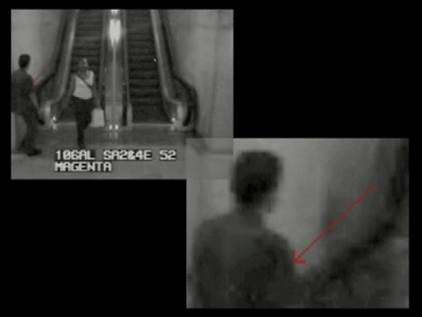
Source. From Gegen-Musik (23 minutes) by H. Farocki, 2004, Harun Farocki Filmproduktion. Copyright 2004 by Harun Farocki/Le Fresnoy. Courtesy of Harun Farocki GbR.
Figure 4: Operational Images - Surveillance Camera Images on the Subway

Source. From Gegen-Musik (23 minutes) by H. Farocki, 2004, Harun Farocki Filmproduktion. Copyright 2004 by Harun Farocki/Le Fresnoy. Courtesy of Harun Farocki GbR.
Figure 5: Operational Images of Sewer Pipes
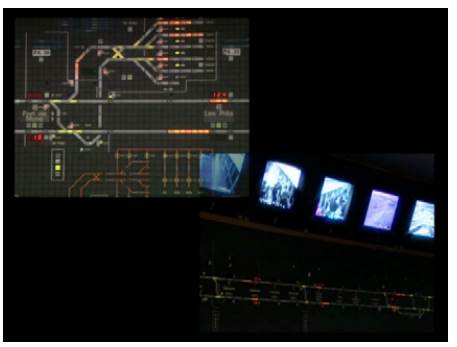
Source. From Gegen-Musik (23 minutes) by H. Farocki, 2004, Harun Farocki Filmproduktion. Copyright 2004 by Harun Farocki/Le Fresnoy. Courtesy of Harun Farocki GbR
Figure 6: Operational Images - Geolocation of Trains on Control Center Panel
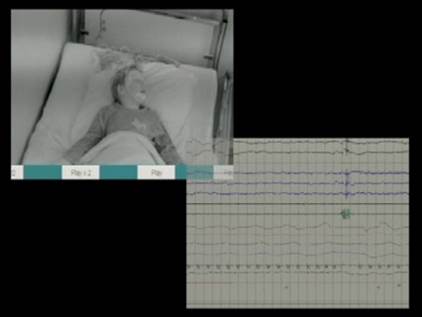
Source. From Gegen-Musik (23 minutes) by H. Farocki, 2004, Harun Farocki Filmproduktion. Copyright 2004 by Harun Farocki/Le Fresnoy. Courtesy of Harun Farocki GbR
Figure 7: Operational Images - Respiratory and Cardiac Graphs Produced in a Sleep Laboratory
All these images form a visual set that corresponds to what the director conceptualizes as operational images. These are, according to the director, objective images that are not made to be watched, but rather have a specific function within the apparatuses of which they are part (e.g., images produced on an industrial assembly line, whose only function is to carry out quality control, or, in the context of interest here, images of sur veillance devices, facial recognition, presence detection, etc.). In short, Farocki highlights these images as having a functional and disposable character: “only in exceptional cases are the tapes not erased and reused”, explains the director (Ehmann et al., 2019). The images speak: what is to be seen does not matter (Ehmann et al., 2019). What matters is the way they allow numerous apparatuses to function in the contemporary city.
This work also allows us to perceive how the importance of light is reiterated, albeit also altered or complexified for the contemporary city’s functioning. “We directed the surveillance cameras toward street light - to catch the moment when they light up”, say a few cards in the film (Farocki, 2004, 00:08:08). After a long wait, the lighting of differ ent street lights is captured by the various surveillance cameras (Figure 8). Even before the day’s blue light has fully disappeared, the reddish street lighting ensures luminosity and visibility in the darkened streets. It is important to emphasize that street lighting makes it possible to produce surveillance images at night, and without it, these images would be pitch-black. From the film, we perceive how light participates today - consistent with its use in modernity - in various control apparatuses in urban spaces. Despite this apparent continuity, however, it is worth questioning what qualitative and quantita- tive differences we can see in contemporary lights.

Source. From Gegen-Musik (23 minutes) by H. Farocki, 2004, Harun Farocki Filmproduktion. Copyright 2004 by Harun Farocki / Le Fresnoy. Courtesy of Harun Farocki GbR.
Figure 8: Operational Lights Enabling Surveillance
In his book La Nuit: Vivre Sans Témoin (Night: Living Without a Witness), Michael Fœssel (2017) elaborates possible elements of response. Fœssel perceives the emergence, in contemporaneity, of a new quality of light - white light - that is appropriate for both the uninterrupted rhythms of neoliberal capitalism and for the functioning of various apparatuses mobilized by security strategies. This new quality of light, indifferent to hours, now floods spaces such as shopping centers and open areas with a glow that is a pure artifact whose purpose is not to illuminate, but to create a space in which the bodies’ movements and the disposition of things become identified at a single glance (Fœssel, 2017, p. 85). White light, therefore, produces a space without shadows, one in which visibility can no longer be escaped. A light that, as Fœssel (2017) notes, presents qualities convenient to surveillance devices, since video security cameras are perfectly adapted to this shadowless whiteness (p. 86).
However, considering this white light the central element of the displacement of power relations through light today seems to us to be an incomplete response to the problem. In addition to this white light,Farocki’s (2004) work marks the emergence of other visualities that, in the contemporary city, are part of several control mechanisms. These are more abstract, algorithmic images, less representative and more informative, such as the respiratory and cardiac graphs produced in a sleep laboratory (Figure 7), which represent a set of operational images. Similarly, it is worth mentioning that images of trains’ geolocation being tracked on a control center panel, of automatic devices de- tecting the presence of or counting people, and even of colored spectra from high-speed trains filmed by a control camera (would this be a thermal image?) are all examples of how Farocki’s film presents the expansion of surveillance towards frequencies and broader regimes of visibility and luminosity. This system is intended to account for indi- viduals passing in crowds (Figure 9), thereby producing an individualizing operation that is crucial to mechanisms of control, with Farocki probably alluding to Deleuze’s text. For, as Deleuze (2013) explains, in the societies of control, individuals “have become ‘dividu- als’, and masses, samples, data, markets, or ‘banks’” (p. 226).
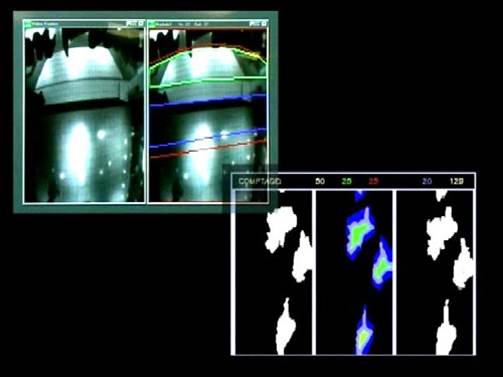
Source. From Gegen-Musik (23 minutes) by H. Farocki, 2004, Harun Farocki Filmproduktion. Copyright 2004 by Harun Farocki / Le Fresnoy. Courtesy of Harun Farocki GbR.
Figure 9: Automatic People-Counting Device
The film also features the backstage of a high-speed control center located in the French city of Lille, where a significant number of monitors aligned in series allow to the observation - thanks to the electronic transmission of images - of the various spaces of the railway network. In this control center, more than 1,200 cameras, their images produced without human operators, simultaneously and automatically record the various spaces to be monitored. Computer-controlled camera devices produce a ubiquitous and machinic vision that strongly resembles the “vision machines” described by Paul Virilio (1988/1994). Devices that, as the author explains, are able to not only monitor but also analyze and automatically interpret what they see, giving birth to an “automation of per ception” (Virilio, 1988/1994, p. 87) - a “sightless vision” (Virilio, 1988/1994, p. 86). It is through machines, therefore, that the city becomes “sensitive” and begins to observe and watch over its inhabitants.
Indirect Light: The Emergence of a New Visibility Regime
Thus, we may ask whether such visualities do not also reveal the emergence of a new quality of light that can illuminate and expose bodies and objects in an indirect way and that would therefore allow the addition of new control mechanisms. Such is the argument of Virilio (2002) in the chapter “La Lumière Indirecte” (Indirect Light) of his book L´Inertie Polaire (Polar Intertia). In this text, the author is first surprised by the widespread emergence, in the late 1970s, of video screens and surveillance cameras that spread through the urban space of Paris. Not by chance, the author recalls, this proliferation occurred shortly after 1968, a year marked by intense student and working-class revolts throughout France. Since then, these cameras have gone on to watch not only the streets and crossroads of the capital, but also the entrances to large schools and universities.
With the dissemination of these videoscopic5 apparatuses, a new quality of light emerged: indirect light, as described by Virilio (2002):
to the daylight of astronomical time should logically be added the daylight of technological speed: from the chemical daylight of candles through the electrical daylight of the Edison lamp (the same Edison who invented the kinetoscope) to the electronic daylight of computer terminals, that deceptive indirect light propagated at the speed of light waves, those transmitter-receivers and other visual generators of duration (emphasis added). (p. 119)
Thus, to the chemical and electrical light regimes, a new quality of indirect light of an electronic nature is added. This implies a shift in the modes of visibility production: although light remains responsible for the revelation of sensitive appearances, “it is (now) its speed which discloses or makes things visible, to the detriment of sunlight or the artificial light of electricity” (Virilio, 2002, p. 108). It is, therefore, less of a light in the traditional sense - i.e. electromagnetic irradiation in the visible range - than a light without light, an electro-optical light, a paroptic light6, a digital light (algorithmic?). This light, Virilio (2002) adds, is based not on the laws of modern optics (i.e., that lenses passively transmit light) but on electronics and computing (i.e., that devices produce or amplify a signal). In a way, it is a more abstract light, close to the idea of visibility that comes from connection.
This displacement also has important repercussions for surveillance technologies, as the author (Virilio, 2002) argues, since indirect light, of an electro-optical nature, al lows the presentation and control of objects or subjects at a distance and in real-time. Thus, the act of seeing, in contemporary times, is not limited to the “direct illumination” of the thing in its presence. Now, the apparatuses also operate remotely, overcoming the need for a physical presence to perform surveillance - they are ubiquitous and there fore omniscient. Hence, unlike the “direct lightning” of electric light, which conducts surveillance on a local scale, “indirect lightning”, found in the new videoscopic media, has transformed local surveillance mechanisms into global reach mechanisms. This new quality of light therefore has, adds Virilio (2002), an analogous function to the warning lamp7, whose main objective is to illuminate the surroundings in which it was diffused, making them visible, watchable and controllable. By overcoming spatial limitations, in- direct light ignores the separation between the public and private spheres and starts to expose bodies in these different spaces.
By the fact that these new surveillance mechanisms enable it, indirect light is inseparable from the emergence and consolidation of control technologies, as described by Deleuze (2013) in his text “Post-Scriptum Sobre as Sociedades de Controle” (Post- script on the Societies of Control). In the brief essay, dating from the early 1990s, the philosopher proposes an update to the disciplinary power mechanisms formulated by Foucault. According to Deleuze, by the end of the 20th century there will have been an intensification of the temporal space range of power mechanisms, such that there are no more gaps in space or time in which one could escape their effects. Tighter than the disciplinary scheme, the new agency of control would become “short-term and of rapid rates of turnover, but also continuous and without limit, while discipline was of long duration, infinite and discontinuous” (Deleuze, 2013, p. 228). Submitted to constant tracking devices and continuously monitored by computers, the individuals of controlled societies would, according to Deleuze, be permanently and everywhere subject to a power capable of exercising this type of control. The author himself highlights the importance of Virilio’s work in understanding these new ultra-fast power mechanisms, which would operate outdoors and continuously.
Overexposure to Operating Lights at the Time
The way in which contemporary technologies mobilize visibility beyond the capac- ity of human vision was also pointed out by Jonathan Crary (2013/2016) in his book 24/7 Capitalismo Tardio e os Fins do Sono (24/7 Late Capitalism and the Ends of Sleep). Converging with the arguments of Virilio (2002) and Deleuze (2013), Crary (2013/2016) underscores the existence of a “modernized panopticism” that expands “well beyond visible wavelengths of light to other parts of the spectrum” (p. 25). By mobilizing “many kinds of non-optical scanners and thermal and bio-sensors”, surveillance mechanisms are no longer restricted to the logic of the visible (Crary, 2013/2016, p. 25). Surveillance cameras (Figure 10), facial recognition and tracking devices (mobile phones, apps, etc.) are some examples of the new ways in which surveillance that crosses the boundaries between public and private spaces can be achieved today, supported by more abstract visibility.

Source. From Gegen-Musik (23 minutes) by H. Farocki, 2004, Harun Farocki Filmproduktion. Copyright 2004 by Harun Farocki/Le Fresnoy. Courtesy of Harun Farocki GbR
Figure 10: Operational Images of a Presence Recognition Device
Moreover, for Crary (2013/2016), these various luminous strategies of power en compass a larger scheme in that he proposes a 24/7 luminosity regime. The author de- parture from his analysis of a series of studies, events, and undertakings reveals a search, in contemporaneity, for the overtaking of the discrepancy between human rhythmic tis- sue (cyclical and inherently limited by the physiological conditions of living beings, which need rest and sleep) and the uninterrupted rhythms of the markets (automatic, based on a technical and inorganic rhythm). Based on this finding, Crary (2013/2016) points out that today’s consolidation of a 24/7 temporality of continuous production, activity and consumption triggers a perpetual illumination and by it is catalyzed (pp. 11-38).
Faced with this new uninterrupted rhythm, Crary (2013/2016) realizes that the “night” - understood as a symbol of the need for rest, reflection and reverie - no lon ger has a space. Consequently, both subjectivities and social relations are affected by this new pulse. On the one hand, individuals now find themselves in a regime of permanent connection in front of various devices and social networks. The author understands that, stimulated, magnetized and sometimes neutralized by the uninterrupted brightness of the 24/7 world, they tend to a state of diffuse attention and semiautomatic conduct. The stimulation would be such that, at the limit, the subjects would even relinquish their own sleep to align themselves with these new rhythmic fabrics. On the other hand, and although we do not intend to dwell on this aspect, it is worth noting this regime of light’s various effects on the social fabric: The atrophy of shared experience and encounters, or even the decline of patience and waiting, are some of the findings made by the author in his book8.
Therefore, the 24/7 light regime outlined by Crary (2013/2016) not only signifies the ambition for full observability that would enable the control of the population (p. 25), but it also impacts, more broadly, the rhythmic fabrics of contemporary ways of living. After characterizing this new regime through images linked to continuous lighting, the author is aware of the fact that we should not consider them literally, at the risk of limiting the understanding of the concept. He suggests, therefore, understanding these images as being symbolic of this new temporality. From this perspective, the author argues that by monopolizing the attention of individuals, the flashes of this light regime would also result in the “incapacitation of daydream or of any mode of absent-minded introspection that would otherwise occur in intervals of slow or vacant time” (2013/2016, p. 97). Everything is illuminated. There is no shadow that enables thought or permits escape from reality or allows the experience of other possible worlds.
The images and operational lights exposed by Farocki (2004) in Gegen-Musik (Counter Music) reveal how they are an integral part of these new power mechanisms, as described by Virilio (2002), Deleuze (2013) and Crary (2013/2016). When watching Farocki’s film, it becomes evident that we are constantly exposed, in contemporary times, to various lights (direct and indirect) that operate various controls on us. We produce, under the artificial and continuous luminosity of these lampes témoin (witnesses’ lamp), traces and reflections (data) of all kinds, and this in a more or less unconscious, involuntary and illegal way. It could even be argued that it has become impossible to live, in contemporary cities, in the (non-existent) shadow of these powerful light fixtures.
Since Virilio (1988/1994, 2002) and Deleuze (2013) wrote their respective texts in the 1990s, major changes to indirect light technologies have occurred, accompanied by an intensification of control technologies. Among these transformations, the exponential growth of mobile phone usage stands out, their screens projecting a continuous indirect light onto their users. In 2017, there were about 5,000,000,000 such devices in the world, and that number is projected to reach 5,900,000,000 by 2025 - 71% of the global population (“Número de Usuários Únicos de Celular Chega a Cinco Bilhões no Mundo”, 2018).
Around the world, street lighting used in modern times is also experiencing an important upgrade. Generally speaking, in addition to replacing the older bulbs with newer and more economical forms (LED technology), public and private initiatives also propose transforming it into intelligent street lighting. This notion essentially proposes converting old lamp posts into connected light poles that would include, beyond light fixtures, several monitoring sensors whose data could serve the city management, as well as become potentially monetizable. Not only video monitoring cameras, but also water level, garbage, parking and people movement sensors are some of the endless possibilities that these new light poles could incorporate. In addition to traditional direct light, poles could (and already do, in certain spaces9) also emit an indirect light onto the bodies transiting public space.
Even if these advances open the door to numerous benefits in terms of urban management, we are concerned about how they could spread and “normalize” the use of control technologies through indirect light. With these changes, the lamp post - an element so widespread in urban territory - could start hosting, for example, camera and surveillance sensors or facial recognition devices. Hereby, the lamp post would become a new type of panopticon without walls - in which illuminating and seeing merge into the same gesture of control - thus concretizing an updated version of the lampe témoin (witness lamp) foreshadowed by Foucault (1975/1999) and Virilio (2002).
Recent debates in France about the controversial “global security law” are equally significant regarding the key role that indirect light plays in today’s mechanisms of popu lation control. Presented at the end of 2020, the bill proposes a series of changes and implementations aimed at strengthening the security apparatus of the French police. The text proposes not only authorizing the transmission in real-time images filmed by body cameras attached to police officers’ bodies, but also facilitating police access to security videos and images. Furthermore, the proposal aims to legalize the use of police drones which, equipped with surveillance devices, could be deployed in many situations, such as the monitoring of popular demonstrations - and all this without the police having to warn the public about the collection of these images (Hourdeaux, 2020). Commenting on the need to pass this bill, congressman Jean-Michel Fauvergue expressed the following regret: “we are losing the war of images (emphasis added) in social networks” (Hourdeaux, 2020, p. 2). The war of images, we would say, is first of all a war of light: the search for total visibility is today dependent on a certain regime of light: indirect.
Raising Insurgent Lights: From Blackout to Disconnection?
We may ask ourselves how, in the face of the intensification of the indirect light regime - given our daily overexposure to various control lights - should we not fear or wait but rather, as Deleuze (2013, p. 224) suggests, seek new weapons? How can we invent new spaces of darkness, of reverie, of waiting, of sleep, of privacy? Perhaps the act of the Parisian insurgents who, in July 1830, destroyed the city’s lanterns would today be as inefficient as it is quixotic. If there is to be any efficiency to a blackout strategy today, it must confront not only the direct lights but also the indirect ones.
This strategy converges on the one Paul Preciado (2020) outlines in the face of the legalization and expansion of a set of “biomolecular technologies that enter into the body by way of microprostheses and technologies of digital surveillance” mobilized in the fight against the covid-19 pandemic (para. 14). Against limiting life through a regime of cybernetic biosurveillance, the philosopher summons us thus: “let us turn off our cell phones, let us disconnect from the internet. Let us stage a big blackout against the satellites observing us, and let us consider the coming revolution together” (Preciado, 2020, para. 32). This argument concurs with Crary’s (2013/2016) proposal to, vying with the flashes of 24/7 luminosity, reassign a space and time to night and sleep. This is because, for this author, there lies in sleep not only a physical but also a symbolic reserve - un derstood as the need for rest, reflection or oneiric reverie - through which one might build protection against 24/7 “order-words” for society as a whole in order to guarantee the durability of social care.
It is also worth mentioning the work of Heather Dewey-Hagborg, artist, research- er, and biohacker, through which she presents possible ways of opposing the complete visibility provided by the various contemporary control technologies. In Stanger Visions (2012-2013), the artist initially draws attention to those mechanisms that threaten any possibility of “darkness”. After proceeding to analyze the deoxyribonucleic acid of strang- ers from traces collected on the street - such as hair, cigarette or chewing-gum remains (Figure 11) - , the artist simulates a 3D model of the person’s face using a program that operates a complex transposition of genetic data into phenotypic criteria.

Source. “Stranger Visions” project page, (website) of the artist Heather Dewey- Hagborg (Dewey-Hagborg, n.d.-a). Copyright 2009-2021 Heather Dewey-Hagborg. Courtesy of Heather Dewey-Hagborg and Fridman Gallery (New York).
Figure 11: Picture of Stanger Visions (2012-2013) Artwork - Vestige of an Unknown Person Collected on the Street
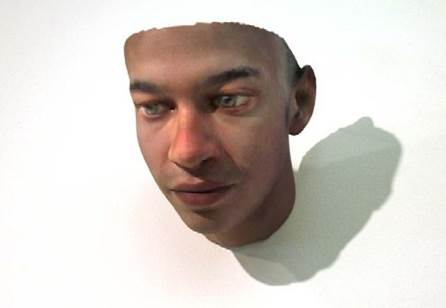
Source. “Stranger Visions” project page, (website) of the artist Heather Dewey- Hagborg (Dewey-Hagborg, n.d.-a). Copyright 2009-2021 Heather Dewey-Hagborg. Courtesy of Heather Dewey-Hagborg and Fridman Gallery (New York).
Figure 12: Picture of Stanger Visions (2012-2013) Artwork - 3D Modeling of the Face of a Stranger, From His Vestige Collected on the Street
This is a way for the artist to signal the already present future under consideration of today’s importance of genetic databases for the apprehension of criminals, that is, of genetic surveillance technologies that could include tracking and recognition systems from mere traces collected on the street, thereby producing an even more inescapable visibility.
In order to rise up against these controls, Dewey-Hagborg (n. d.-b) proposes strategies of biopolitical subversion in another of her works, The Official Biononymous Guidebooks. In it, the artist produces an explanatory booklet, given to exhibition visitors, within which she lists the steps to follow to remove all traces of deoxyribonucleic acid from an object (Figures 13 and 14). Thus, she contributes to the reflection on what we could call an aesthetic of opacity, or even an aesthetic of the protection of privacy.

Source. “The Official Biononymous Guidebooks” project page, (website) by the artist Heather Dewey-Hagborg (Dewey-Hagborg, n.d-b). Copyright 2009-2021 Heather Dewey- Hagborg. Courtesy of Heather Dewey-Hagborg and Fridman Gallery (New York).
Figure 13: Photograph of The Official Biononymous Guidebooks (2015) - Booklet’s Outside

Source. “The Official Biononymous Guidebooks” project page, (website) by the artist Heather Dewey-Hagborg (Dewey-Hagborg, n.d-b). Copyright 2009-2021 Heather Dewey- Hagborg. Courtesy of Heather Dewey-Hagborg and Fridman Gallery (New York).
Figure 14: Photograph of The Official Biononymous Guidebooks (2015) - Booklet’s Inside
The biopolitical instrumentalizations of light, however, are multiple and present abundant operative modes. The variety and complexity of these technologies of power could therefore demand multiple responses and protection strategies that are equally diverse. In this sense, we believe that the attempt to neutralize light (direct or non-direct) and the resulting dive into a “protective darkness”, as suggested in Dewey-Hagborg’s (n.d.-b) work, is only one of several ways in which we might elicit the stored opposition in the face of this new regime of luminosity.
Taking a different tack from these subtractive strategies, there are the additive practices of light that could, in our view, present a prolific inspiration for the construction of counterlights. If, on the one hand, the use of mobile phones has allowed the development of new technologies to control the population, on the other hand, it has also significantly spread the possibility to not only record events in various formats (photography, videography, sound), but also share or transmit them instantaneously. These devices thus open up the possibility for the individual to project and transmit their own indirect light across the world.
This particular use of mobile digital devices has long been fruitful, and allows, for example, capturing and publishing - in some cases even inhibiting - police violence. Regarding this issue, it is symptomatic that the aforementioned “global security law” in France precisely envisages, in addition to the expansion of police digital surveillance resources, the concomitant reduction of the possibility for the population to similarly employ such resources. Indeed, the bill proposes criminalizing the disclosure of images that identify police officers - when filmed in the course of their duties and with the intent to harm their “physical or psychological integrity” - which opponents of the law consider to be characterized by a high degree of subjectivity (Hourdeaux, 2020). Therefore, in this bill, the enormous relevance of indirect light in contemporary power networks crystallizes, as does, more broadly, the importance of visibility in current relations between authorities and the population.
We should also look away from the European context to better explore possible inspiring strategies. In Chile, for example, the popular demonstrations against social inequality that took place between October 2019 and April 2020 also instigate reflection on this problem. Sparked by student protests against the increase in the subway fare in Santiago, the episode, initially localized, quickly spread throughout the country, sparking a wave of massive, cross-generational and cross-cutting actions, marches and protests as well as clashes with the national authorities. In response to the protests, the federal government, led by right-wing businessman Sebastián Piñera, declared a state of emer- gency and sent military forces to the streets to restore public order (Abufom Silva, 2020). The escalation of tension in the management of the conflict led to violent street clashes between protesters and the forces of order, which brought to light, through professional and amateur media, spectacular images of a new light war. When confronting the police, the Chilean insurgents armed with handheld lasers, massively confronted the police with these lights that were intended, if not to blind the authorities and the means of surveillance of the protests, at least hinder them. Videos posted on social media by protesters testify how these rays (Figure 15) - whose individual brightness is relatively weak, but which constitute an intense flash when added together - managed to not only dazzle a police vehicle and a helicopter pilot but also attack a drone which, dulled by the powerful light, was deflected before falling to the ground.
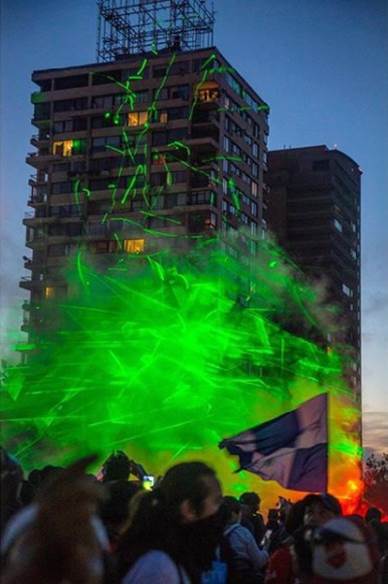
Source. By T. Canelo (tribitrip), 2019, Instagram. Copyright 2019 by Tribi Canelo. Courtesy of Tribi Canelo.
Figure 15: Photograph of protests in Santiago, December 2019
This additive strategy of lights is also that used by some military planes, which flash intense lights from all sides to confuse and escape a missile’s automatic targeting system (Figure 16), as Farocki (2003) points out in his film Erkennen und Verfolgen (War at a Distance). As paradoxical as it may seem, throwing light can, therefore, also allow us to dazzle, to blind - to make night. As the Chilean insurgents already demonstrated: with their united lasers, they were able to evade the control of the authorities in the Chilean streets, thereby inaugurating the possibility of collective strategies capable of fighting the individualizing mechanisms of societies of control.
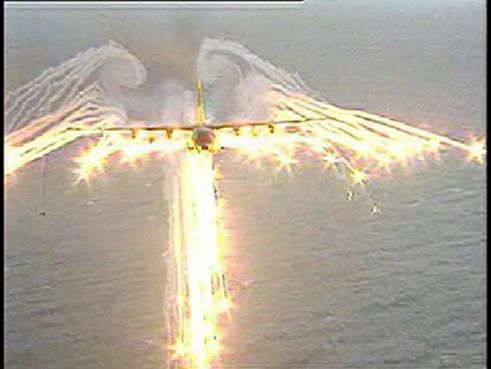
Source. From Erkennen und Verfolgen (58 minutes) by H. Farocki, 2003, Harun Farocki Filmproduktion. Copyright 2003 by ZDF / Harun Farocki Filmproduktion. Courtesy of Harun Farocki GbR.
Figure 16: Military Aircraft Using a Light-Based Stealth System
Conclusion
In order to illuminate the power relations established through light - what we understand as photo-politics -, we first show how modern Paris was the scene of several strategies that relied on the visibility produced through public lighting.These direct lights made the population visible and supervisable by the authorities, a necessary condition for the application of disciplinary power. Today, the power strategies that cross the urban fabric of large Western cities are configured differently, as we perceive through the work of Farocki (2004) work. In these environments, we see that the emergence of new indirect light has allowed the space-time intensification of control, causing relations of forces to exceed the limits of physical space, thus moving away from the mechanism present in disciplinary institutions. Moreover, the nature of the vigilant eye shifts: if in the modern city, control still assumes a human gaze, this is increasingly expendable as various devices turn to the machinic eye. We also ask ourselves whether overexposure to indirect light, which permits the incessant production of marketable data on the population, does not signify, in so-called intelligent cities, a greater inflection in the convergence of surveillance mechanisms with economic strategies. Finally, we analyze artistic, theoretical and social propositions that formulate inspiring strategies in order to rise up against these control apparatuses.
Through this brief genealogy, we evidence how the modern and contemporary materialities of light - understood as media - enable, catalyze and reflect certain mediations of power in the analyzed urban fabrics. Furthermore, if, according to the Fou- caultian perspective, power materially intervenes, reaching the most concrete reality of individuals - the body - and is situated at the level of the social body itself, rather than above it, penetrating into everyday life (Machado, 2019, p. 14), we hope to have stressed the importance of considering light’s protagonism not only in the establishment of such power relations, but also in the imagination and eruption of insurgent lights.
acknowledgements
To Tadeu Capistrano and Paula Sibilia for the fundamental help in this research. To Bruna Freitas for the revision of the text and for the support in its elaboration. To Isabela Abreu and Laura Davies for the translation work. To Tribi Canelo, Heather Dewey-Hagborg and Antje Ehmann for the assignment of the images.
REFERENCES
Abufom Silva, P. (2020, 4 de março). Los seis meses que transformaron Chile: Balance transitorio de la revuelta contra la precarización de la vida. Rebelión. https://rebelion.org/los-seis-meses-que-transformaron-chile/ [ Links ]
Benjamin, W. (2009). Passagens (I. Aron & C. P. B. Mourão, Trad.). UFMG. (Trabalho original publicado em 1982) [ Links ]
Boileau, N. (1872). Œuvres poétiques de Boileau, tome premier. Publication de l’Imprimerie Générale. https://fr.wikisource.org/wiki/Boileau_-_%C5%92uvres_po%C3%A9tiques/Satires/Satire_VI [ Links ]
Canelo, T. (tribitrip) (2019, 14 de dezembro). Fotografias das manifestações chilenas em Santiago (Fotografias) https://www.instagram.com/p/B6DMl2xJyM3/ [ Links ]
Crary, J. (2016). 24/7 Capitalismo tardio ou os fins do sono (J. Toledo Jr ., Trad.). Ubu Editora. (Trabalho original publicado em 2013) [ Links ]
Deleuze, G. (2013). Conversações. Editora 34. [ Links ]
Delumeau, J. (2009). História do medo no ocidente 1300-1800 (M. L. Machado, Trad.). Companhia das Letras. (Trabalho original publicado em 1978) [ Links ]
Dewey-Hagborg, H. (s.d.-a). Stanger visions. https://deweyhagborg.com/projects/stranger-visions [ Links ]
Dewey-Hagborg, H. (s.d.-b). The official biononymous guidebooks. https://deweyhagborg.com/projects/the-official-biononymous-guidebooks [ Links ]
Ehmann, A., Espada, H., & Barzon, M. (2019). Catálogo da exposição ‘Harun Farocki: quem é responsável?’.Instituto Moreira Salles. [ Links ]
Farocki, H. (Realizador). (2003). Erkennen und Verfolgen (Filme) . Harun Farocki Filmproduktion. [ Links ]
Farocki, H. (Realizador). (2004). Gegen-Musik (Filme) Harun Farocki Filmproduktion; Le Fresnoy. [ Links ]
Figuier, L. (1867). Les merveilles de la science. https://fr.wikisource.org/wiki/Livre:Figuier_-_Les_Merveilles_de_la_science,_1867_-_1891,_Tome_4.djvu [ Links ]
Fœssel, M. (2017). La nuit: Vivre sans témoin. Éditions autrement. [ Links ]
Foucault, M. (1999). Vigiar e punir: Nascimento da prisão (M.T. C. Albuquerque & J. A. G. Albuquerque, Trad.) Editora Vozes. (Trabalho original publicado em 1975) [ Links ]
Hourdeaux, J. (2020, 17 de novembro). Loi «sécurité globale»: Un patchwork sécuritaire examiné à l’Assemblée. Mediapart. https://www.mediapart.fr/journal/france/171120/loi-securite-globale-un-patchwork-securitaire-examine-l-assemblee [ Links ]
Juazeiro do Norte. (2018, 6 de novembro). Juazeiro do Norte lança projeto de PPP para ‘smart city’. https://www.juazeirodonorte.ce.gov.br/noticia/5553-juazeiro-do-norte-lanca-projeto-de-ppp-para-smart-city/ [ Links ]
Machado, R. (2019). Por uma genealogia do poder. In M. Foucault, Microfísica do poder (pp. 7-34). Paz & Terra. [ Links ]
Número de usuários únicos de celular chega a cinco bilhões no mundo. (2018, 27 de fevereiro). O Globo. https://oglobo.globo.com/economia/numero-de-usuarios-unicos-de-celular-chega-cinco-bilhoes-no-mundo-22436866 [ Links ]
Preciado, P. B. (2020). Aprendendo do vírus (A. L. Braga & D. Kraus, Trad.). n-1 edições. https://www.n-1edicoes.org/textos/26 [ Links ]
Schivelbusch, W. (1993). La nuit désenchantée (A. Weber, Trad.). Éditions Gallimard. (Trabalho original publicado em 1983) [ Links ]
Sibilia, P. (2002). O homem pós-orgânico. Corpo, subjetividade e tecnologias digitais. Relume Dumará. [ Links ]
Vertov. D. (Realizador). (1929). Man with a movie camera (Filme) . All-Ukrainian Photo Cinema Administration. [ Links ]
Virilio, P. (1994). A máquina de visão (P. R. Pires, Trad.). José Olympio Editora. (Trabalho original publicado em 1988) [ Links ]
Virilio, P. (2002). L´inertie polaire. Christian Bourgois Editeur. [ Links ]
1The translators mentioned below are responsible for the translation of part of the excerpts quoted in this version A. Davies, H. Eiland and K. McLaughlin, A. Sheridan, H. Eiland, E. Jephcott, R. Livingston and H. Zohn, M. Stevens.
2The panopticon is an architectural model proposed by Jeremy Bentham in the late 18th century that allows a guard to observe, from a central tower, each cell exposed by light. Through this apparatus, the movements of each individual are, therefore, constantly exposed (Foucault, 1975/1999).
3To understand the participation of public lighting in power strategies, we must not lose sight of its importance for urban night security. The consequent decrease in crime has been frequently proven by studies, such as that cited by Jean Delumeau (1978/2009) in his História do Medo no Ocidente 1300-1800 (History of Fear in Western Culture 1300-1800). In this book, the author gives the example of St. Louis, Missouri, which experienced a 41% decrease in auto theft and a 13% reduction in burglaries a year after it installed a major lighting program (Delumeau, 1978/2009, p. 149). We may wonder, however, whether street lighting might not displace (and/or perhaps transform) acts of crime without necessarily addressing their underlying causes
4Gegen-Musik does not seem to be concerned with specifying an accurate and unique spatial location. The film, by employing images of different cities in the northern region of France, thus becomes representative of a more general portrait of today’s western metropolis.
5We can understand videoscopic equipment as a set of “electro-optical” devices capable of producing some form of potentially transmissible real-time visibility, such as live transmitted videos and geolocation systems, but also military night vision binoculars, and so forth.
6 “Paroptique”, in the original text, refers to an extra-retinal vision as is found, for example, in frogs, which possess the ability to “see” with their skin to some extent.
7 Virilio (2002) argues that the miniaturization of video equipment makes it increasingly like the “warning lamp” (lampe- -témoin in the original, meaning also witness lamp), whose primary function is to illuminate what is in front of the viewer. Lampe-témoin is a word that must be understood here in its semantic polysemy in that it allows not only to illuminate, but also to observe: a confusion between the gaze and the source of light that Foucault (1975/1999) already described as an ideal representation of the disciplinary apparatus in Vigiar e Punir: Nascimento da Prisão
8The diversity of Crary’s (2013/2016) proposed notion is also what could, in our view, constitute one of his fragilities. When mingling various effects into a single concept, we wonder if the author does not move away, somehow, from the greater conceptual precision proposed by Virilio (2002).
9As is currently the case, for example, in Juazeiro do Norte, Brazil (Juazeiro do Norte, 2018).
Received: January 30, 2021; Accepted: April 02, 2021











 texto em
texto em 



